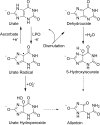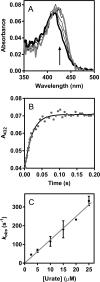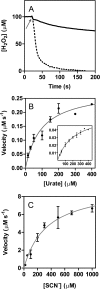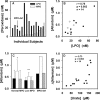Uric acid and thiocyanate as competing substrates of lactoperoxidase
- PMID: 24928513
- PMCID: PMC4139211
- DOI: 10.1074/jbc.M113.544957
Uric acid and thiocyanate as competing substrates of lactoperoxidase
Abstract
The physiological function of urate is poorly understood. It may act as a danger signal, an antioxidant, or a substrate for heme peroxidases. Whether it reacts sufficiently rapidly with lactoperoxidase (LPO) to act as a physiological substrate remains unknown. LPO is a mammalian peroxidase that plays a key role in the innate immune defense by oxidizing thiocyanate to the bactericidal and fungicidal agent hypothiocyanite. We now demonstrate that urate is a good substrate for bovine LPO. Urate was oxidized by LPO to produce the electrophilic intermediates dehydrourate and 5-hydroxyisourate, which decayed to allantoin. In the presence of superoxide, high yields of hydroperoxides were formed by LPO and urate. Using stopped-flow spectroscopy, we determined rate constants for the reaction of urate with compound I (k1 = 1.1 × 10(7) M(-1) s(-1)) and compound II (k2 = 8.5 × 10(3) M(-1) s(-1)). During urate oxidation, LPO was diverted from its peroxidase cycle because hydrogen peroxide reacted with compound II to give compound III. At physiologically relevant concentrations, urate competed effectively with thiocyanate, the main substrate of LPO for oxidation, and inhibited production of hypothiocyanite. Similarly, hypothiocyanite-dependent killing of Pseudomonas aeruginosa was inhibited by urate. Allantoin was present in human saliva and associated with the concentration of LPO. When hydrogen peroxide was added to saliva, oxidation of urate was dependent on its concentration and peroxidase activity. Our findings establish urate as a likely physiological substrate for LPO that will influence host defense and give rise to reactive electrophilic metabolites.
Keywords: Host Defense; Kinetics; Peroxidase; Pre-steady-state Kinetics; Uric Acid.
© 2014 by The American Society for Biochemistry and Molecular Biology, Inc.
Figures











Similar articles
-
Lactoperoxidase-catalyzed oxidation of thiocyanate by hydrogen peroxide: 15N nuclear magnetic resonance and optical spectral studies.Biochemistry. 1991 Jan 8;30(1):118-24. doi: 10.1021/bi00215a018. Biochemistry. 1991. PMID: 1988011
-
Standard reduction potentials of all couples of the peroxidase cycle of lactoperoxidase.J Inorg Biochem. 2005 May;99(5):1220-9. doi: 10.1016/j.jinorgbio.2005.02.021. J Inorg Biochem. 2005. PMID: 15833345
-
Reaction of ferrous lactoperoxidase with hydrogen peroxide and dioxygen: an anaerobic stopped-flow study.Arch Biochem Biophys. 2005 Feb 1;434(1):51-9. doi: 10.1016/j.abb.2004.10.014. Arch Biochem Biophys. 2005. PMID: 15629108
-
Lactoperoxidase as a potential drug target.Expert Opin Ther Targets. 2016;20(4):447-61. doi: 10.1517/14728222.2016.1112378. Epub 2015 Nov 11. Expert Opin Ther Targets. 2016. PMID: 26558497 Review.
-
Lactoperoxidase: Properties, Functions, and Potential Applications.Int J Mol Sci. 2025 May 24;26(11):5055. doi: 10.3390/ijms26115055. Int J Mol Sci. 2025. PMID: 40507866 Free PMC article. Review.
Cited by
-
Unraveling the effects of uric acid on endothelial cells: A global proteomic study.Redox Biol. 2025 May;82:103625. doi: 10.1016/j.redox.2025.103625. Epub 2025 Apr 1. Redox Biol. 2025. PMID: 40203480 Free PMC article.
-
Uric acid disrupts hypochlorous acid production and the bactericidal activity of HL-60 cells.Redox Biol. 2018 Jun;16:179-188. doi: 10.1016/j.redox.2018.02.020. Epub 2018 Mar 1. Redox Biol. 2018. PMID: 29510342 Free PMC article.
-
Purification of lactoperoxidase from bovine whey and investigation of kinetic parameters.Adv Biomed Res. 2016 Nov 28;5:189. doi: 10.4103/2277-9175.192738. eCollection 2016. Adv Biomed Res. 2016. PMID: 28028529 Free PMC article.
-
Integrating metabolomics and network pharmacology to assess the effects of quercetin on lung inflammatory injury induced by human respiratory syncytial virus.Sci Rep. 2023 May 17;13(1):8051. doi: 10.1038/s41598-023-35272-8. Sci Rep. 2023. PMID: 37198253 Free PMC article.
-
The role of metals in hypothiocyanite resistance in Escherichia coli.J Bacteriol. 2024 Aug 22;206(8):e0009824. doi: 10.1128/jb.00098-24. Epub 2024 Jul 17. J Bacteriol. 2024. PMID: 39016617 Free PMC article.
References
-
- Becker B. F. (1993) Towards the physiological function of uric acid. Free Radic. Biol. Med. 14, 615–631 - PubMed
-
- Wayner D. D. M., Burton G. W., Ingold K. U., Barclay L. R. C., Locke S. J. (1987) The relative contributions of vitamin E, urate, ascorbate and proteins to the total peroxyl radical-trapping antioxidant activity of human blood plasma. Biochim. Biophys. Acta 924, 408–419 - PubMed
-
- Uotila J., Metsa-Ketela T., Tuimala R. (1992) Plasma peroxyl radical-trapping capacity in severe preeclampsia is strongly related to uric acid. Clin. Exp. Hypertens. B b11, 71–80
Publication types
MeSH terms
Substances
LinkOut - more resources
Full Text Sources
Other Literature Sources
Molecular Biology Databases

